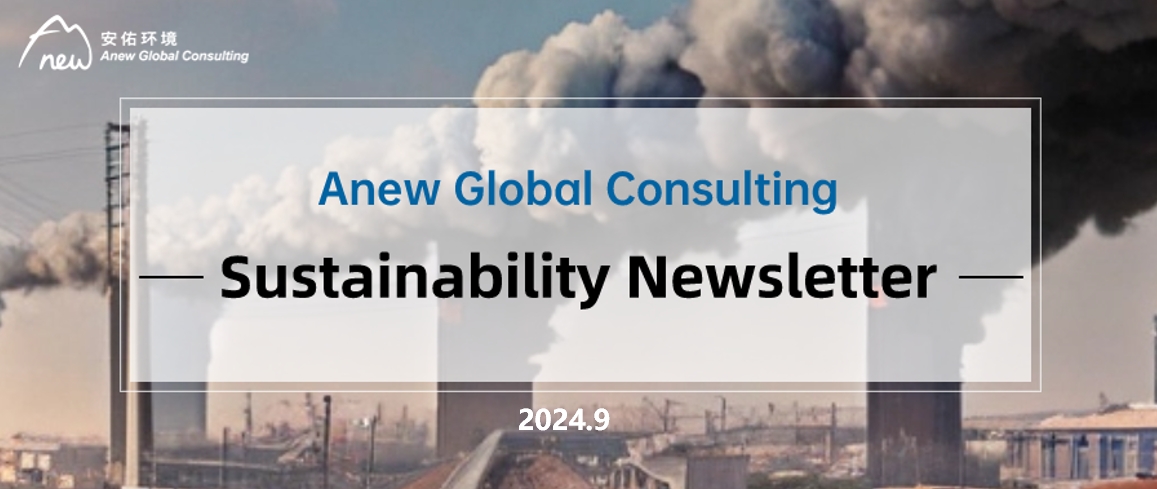Carbon Emission Newsletter -October,2024

No.1
EU Urges Member States to Achieve Their Energy Goals by the Year 2030
On September 11th, the European Commission unveiled the State of the Energy Union Report 2024. This document emphasizes the urgency for all EU Member States to promptly submit their refined National Energy and Climate Plans (NECPs) to ensure collective achievement of the 2030 energy and climate goals. Furthermore, the report underscores the importance of fostering collaborative relationships with the industry to expedite the advancement of technologies aimed at achieving a net-zero carbon footprint and to bolster the EU's industrial capabilities.
No.2
MEE Attends SCIO's Press Conference on the “Promoting High-Quality Development" Series, Highlighting Carbon Market Expansion
On September 25, the State Council Information Office (SCIO) convened a press conference with representatives from the Ministry of Ecology and Environment to discuss the strategies for fostering high-quality development. Minister Huang Runqiu detailed the initiatives of realizing the "Beautiful China" vision. This includes the rollout of the "1+1+N" action plan, the progression of critical reforms in tailored environmental governance for different regions, the initiation of pilot programs such as "Beautiful Bays" and "Zero-Waste Cities," and the establishment of a suite of comprehensive support policies. Vice Minister Zhao Yingmin provided an overview of the advancements in the carbon trading market and outlined forthcoming measures. These measures comprise the refinement of carbon emissions accounting methods, the expansion of the market for carbon trading, and the strengthening of regulatory oversight.
No.3
NEA and MEE issued a notice to better align the green electricity certificates with the voluntary greenhouse gas emissions reduction trading market
The notice sets a transitional phase of two years, commencing on October 1, 2024, during which proprietors of offshore wind and solar thermal ventures that fulfill the CCER standards can submit applications for either CCERs or GECs. Throughout this interval, novel photovoltaic and additional wind initiatives will be excluded from the voluntary carbon reduction marketplace. Upon the conclusion of this transition, the strategy for merging and linking GECs with CCERs will be appraised and fine-tuned in light of practical experience. The objective of the notice is to avert the dual counting of advantages and to bolster regulatory oversight.
No.4
The second draft of the Energy Law further promotes the green and low-carbon energy transformation
On September 10th, a proposal for an energy law was presented to the Standing Committee of the National People’s Congress for its second deliberation. The draft law includes fresh regulations governing the advancement and exploitation of renewable energy sources, such as wind, solar, biomass, geothermal, ocean, and hydrogen energy. Addressing previous feedback, it proposes initiatives for developing an innovative power system and enhancing the integrated development of power generation and grid infrastructure to more efficiently integrate, distribute, and manage clean energy resources. Moreover, the draft promotes the use of clean and low-carbon energy by end-users through the establishment of a mechanism that fosters green energy consumption.
No.5
SAMR, MEE, and NDRC release the “Guidance Catalogue for Carbon Emission Measurement Capacity Building”

The Guidance Catalogue specifies 39 crucial metrics for measurement, 82 standardized testing procedures, 108 types of measuring instruments and equipment, 85 national standards for metrology, and 55 public standards in the field of metrology. By ensuring precise measurement of these parameters, it tackles previous challenges related to poor quality carbon emission data, non-traceable measurements, and incomplete traceability chains. This catalog provides robust scientific benchmarks for major emitters to enhance energy conservation and emission reduction efforts. Additionally, it delivers unambiguous directives to metrology organizations and stakeholders involved in voluntary carbon offset projects.
-END-